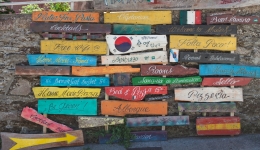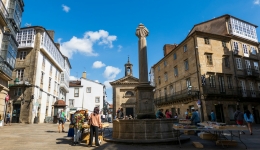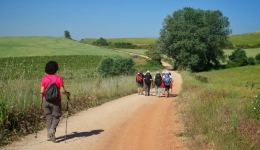The French way
Without doubt the itinerary with the most historical tradition in the Camino de Santiago. This French born route borders around the Pyrenees and Crosses the Iberian Peninsula from east to west. Approaching Galicia by the legendary climb to O Cebreiro.
The Northern Way
Pilgrimage route via the Asturian- Galician coast, the Camino dates back to the IX century. Reaching Galician soil in Ribadeo.
The Primitive Way
The oldest route in the Camino de Santiago is now considered by many to be the one of greatest beauty, of challenging layout, yet not too crowded, it follows the footsteps of the first pilgrims.
English Way
The route taken by pilgrims from northern and western Europe who arrived by boat to the coast of A Coruña and continued on foot to Santiago
The Portuguese Way
A Medieval route of the Camino de Santiago that runs north from Portugal and enters Galicia on the banks of the River Miño
The Finisterre – Muxia Way
A single path with its departure point in Santiago and with its end goal at the Cape of Finisterre, the westernmost point of Europe and the Sanctuary of Virxe de Barca in Muxia.
The Sea Route of Arousa and of the Ulla river
From O Grove or Ribeira to Padrón, it mimics the route taken by boat with the remains of the Apostle
Other ways to Santiago
In addition to the Jacobean routes recognized as "official" there are many other pilgrimage routes of long tradition that travel throughout the Peninsula.
Routes of the Camino de Santiago
Planning Camino de Santiago for the traveler who wants to face this adventure begins with a simple but important question: what route we choose? This decision will mark our experience as pilgrims, as among the most popular routes we can choose, has nothing to do with a trip to the the Northern Way, between coast and mountains, compared with a trip through the French Way, through the inside and much trodden by pilgrims.
The French Way, the most commonly used route
There are multiple options to address the Camino de Santiago, with routes that pass virtually all the geography of the peninsula and not just the north of it, contrary to what many believe. However we could reduce to five the most popular routes or traveled by pilgrims from all over the world: the French Way, the Northern Way, the Primitive Way, the Portuguese Way and the English Way, although of course there are other alternatives.
Undoubtedly the most popular and busiest route of all is the French Way, whose starting points are found in Roncesvalles and Somport. It is the way par excellence, traditionally used by pilgrims from all over Europe to reach Santiago and network services, accommodations and most complete of all signaling. We find your path passing through a wealth of history, although it should be taken with philosophy massification of this route at certain points, especially at the end of its travel.
The North Road, the route of the Cantabrian Mountains
Not so crowded, but very popular route is the Northern Way, pilgrims path originally used in the Middle Ages to avoid the Muslim kingdoms on his way to Compostela. With starting point in Irún, the pilgrim will cross the Asturian-Galician coastline with inclement weather and altitude as main obstacles on the road, stepping down in Ribadeo, Galicia. On arrival to the city of Oviedo, the road forks into two, pilgrims can follow the Camino Primitivo, which takes us inside.
The Primitive Way is another option to find the pilgrims. Despite being the much shorter route than other routes, with starting point in Oviedo and passing places like A Fonsagrada, its demand should not be taken lightly. It is a route of great beauty, and therein lies the honor of being the original path traveled by the first pilgrims, King Alfonso II, on his way to Compostela to the grave of the apostle Santiago. His popularity moved to the French Way in the Middle Ages by the phenomenon of the Reconquista has not meant that this route is lost, fortunately.
The Portuguese Way, with starting point in Lisbon
If we decide to do the Camino de Santiago from Portuguese lands, we always have the option of making the Portuguese Way, with starting point in Lisbon, crossing the atlantic country from south to north and crossing the River Minho to enter Galicia by Tui, visiting more later Pontevedra and localities as Padron, before reaching Santiago. Finally, we found one of the most popular routes the English Way, frequented in the Middle Ages by pilgrims English, Scottish, Irish, Scandinavian or Flemish to reach Santiago through the port of A Coruña. We can expect a well-signposted but with a certain lack of services and accommodation compared to other routes too little crowded path. The English Way has two variants, from A Coruña (Camiño do Faro) and from the town of Ferrol.
Routes
Blog
 How to get to Sarria to do the Camino de Santiago
How to get to Sarria to do the Camino de Santiago
 Descubre la magia del Camino de Santiago Portugués por la costa
Descubre la magia del Camino de Santiago Portugués por la costa
 5 tours culturales que puedes hacer en Galicia si decides hacer un alto en el camino
5 tours culturales que puedes hacer en Galicia si decides hacer un alto en el camino
 Doing the Camino de Santiago in June: What you should know?
Doing the Camino de Santiago in June: What you should know?
Information
Points of interest
Cities & Towns | Hostels | Lodgings | Restaurants | Saddlery | Doctors | Points of interest | Bikes workshop
Contact us | Privacy policy | Cookies policy | | Terms of use | Authorship | Web Map | Consentimiento
© Copyright LA VOZ DE GALICIA S.A. Polígono de Sabón, Arteixo, A CORUÑA (ESPAÑA) Inscrita en el Registro Mercantil de A Coruña en el Tomo 2438 del Archivo, Sección General, a los folios 91 y siguientes, hoja C-2141. CIF: A-15000649
Developed and managed byHyliacom

